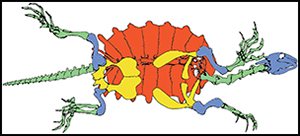Crossref Citations
This article has been cited by the following publications. This list is generated based on data provided by
Crossref.
Hayden, Brian
2018.
The Power of Ritual in Prehistory.
Berthon, Rémi
2018.
A ritual deposit of fox remains at Ovçular Tepesi (Nakhchivan, Azerbaijan) and its relation with the pastoral nature of Late Chalcolithic communities.
Journal of Archaeological Science: Reports,
Vol. 20,
Issue. ,
p.
930.
Safaei-Mahroo, Barbod
and
Ghaffari, Hanyeh
2021.
Tigris and Euphrates Rivers: Their Environment from Headwaters to Mouth.
p.
975.
Masseti, Marco
2021.
Tigris and Euphrates Rivers: Their Environment from Headwaters to Mouth.
p.
13.
Chroust, Milan
Mazuch, Martin
Ivanov, Martin
Alba, David M.
and
Luján, Àngel H.
2023.
Redescription of the soft-shell turtleRafetus bohemicus(Testudines, Trionychidae) from the Early Miocene of Czechia.
PeerJ,
Vol. 11,
Issue. ,
p.
e15658.
AIDEK, AHMAD E.
SAAD, ADIB
JABLONSKI, DANIEL
ESTERBAUER, HANS
and
FRITZ, UWE
2024.
Turtles and tortoises of Syria: Diversity, distribution, and conservation.
Zootaxa,
Vol. 5506,
Issue. 2,
p.
151.
Satiro, Ana
Gomes de Almeida, Isabel
and
Brito, Cristina
2024.
The Importance of Aquatic Fauna on Ancient Mesopotamian Healing Practices—An Environmental Humanities Approach to Human Dependency of Non-Human World.
Humanities,
Vol. 13,
Issue. 1,
p.
25.
Barzilai, Omry
Marder, Ofer
Tejero, José-Miguel
Ayalon, Avner
Bar-Matthews, Miryam
Abulafia, Talia
Lavi, Ron
Goder-Goldberger, Mae
Shemer, Maayan
Edeltin, Lotan
Wiegmann, Alexander
Frumkin, Amos
Karasik, Avshalom
Yasur, Gal
Yeshurun, Reuven
Zohar, Irit
Berna, Francesco
Hans, Mark
Goldberg, Jerold S.
McDermott, Yvonne
Spurlock, Linda
Pokhojaev, Ariel
Habashi, Waseem
May, Hila
Sarig, Rachel
and
Hershkovitz, Israel
2024.
Early human collective practices and symbolism in the Early Upper Paleolithic of Southwest Asia.
Proceedings of the National Academy of Sciences,
Vol. 121,
Issue. 51,
